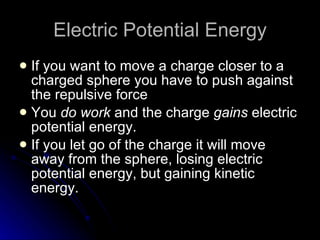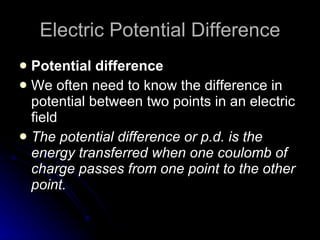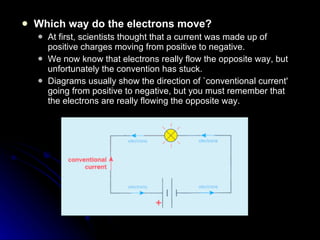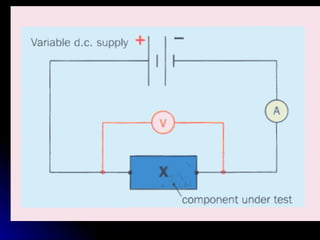5.1
- 1. Electric Currents Topic 5 .1 Electric potential difference, current and resistance
- 2. Electric Potential Energy If you want to move a charge closer to a charged sphere you have to push against the repulsive force You do work and the charge gains electric potential energy. If you let go of the charge it will move away from the sphere, losing electric potential energy, but gaining kinetic energy.
- 3. When you move a charge in an electric field its potential energy changes. This is like moving a mass in a gravitational field.
- 4. The electric potential V at any point in an electric field is the potential energy that each coulomb of positive charge would have if placed at that point in the field. The unit for electric potential is the joule per coulomb (J C ‑1 ), or the volt (V). Like gravitational potential it is a scalar quantity.
- 5. In the next figure, a charge +q moves between points A and B through a distance x in a uniform electric field. The positive plate has a high potential and the negative plate a low potential. Positive charges of their own accord, move from a place of high electric potential to a place of low electric potential. Electrons move the other way, from low potential to high potential.
- 7. In moving from point A to point B in the diagram, the positive charge +q is moving from a low electric potential to a high electric potential. The electric potential is therefore different at both points.
- 8. In order to move a charge from point A to point B, a force must be applied to the charge equal to qE (F = qE). Since the force is applied through a distance x, then work has to be done to move the charge, and there is an electric potential difference between the two points. Remember that the work done is equivalent to the energy gained or lost in moving the charge through the electric field.
- 9. Electric Potential Difference Potential difference We often need to know the difference in potential between two points in an electric field The potential difference or p.d. is the energy transferred when one coulomb of charge passes from one point to the other point.
- 10. The diagram shows some values of the electric potential at points in the electric field of a positively‑charged sphere What is the p.d. between points A and B in the diagram?
- 12. When one coulomb moves from A to B it gains 15 J of energy. If 2 C move from A to B then 30 J of energy are transferred. In fact:
- 13. Change in Energy Energy transferred, This could be equal to the amount of electric potential energy gained or to the amount of kinetic energy gained W =charge, q x p.d.., V (joules) (coulombs) (volts)
- 14. The Electronvolt One electron volt (1 eV) is defined as the energy acquired by an electron as a result of moving through a potential difference of one volt. Since W = q x V And the charge on an electron or proton is 1.6 x 10 -19 C Then W = 1.6 x 10 -19 C x 1V W = 1.6 x 10 -19 J Therefore 1 eV = 1.6 x 10 -19 J
- 15. Conduction in Metals A copper wire consists of millions of copper atoms. Most of the electrons are held tightly to their atoms, but each copper atom has one or two electrons which are loosely held. Since the electrons are negatively charged, an atom that loses an electron is left with a positive charge and is called an ion.
- 17. The diagram shows that the copper wire is made up of a lattice of positive ions, surrounded by free' electrons: The ions can only vibrate about their fixed positions, but the electrons are free to move randomly from one ion to another through the lattice. All metals have a structure like this.
- 18. What happens when a battery is attached to the copper wire? The free electrons are repelled by the negative terminal and attracted to the positive one. They still have a random movement, but in addition they all now move slowly in the same direction through the wire with a steady drift velocity. We now have a flow of charge ‑ we have electric current.
- 19. Electric Current Current is measured in amperes (A) using an ammeter. The ampere is a fundamental unit. The ammeter is placed in the circuit so that the electrons pass through it. Therefore it is placed in series. The more electrons that pass through the ammeter in one second, the higher the current reading in amps.
- 20. 1 amp is a flow of about 6 x 10 18 electrons in each second! The electron is too small to be used as the basic unit of charge, so instead we use a much bigger unit called the coulomb (C). The charge on 1 electron is only 1.6 x 10 ‑19 C.
- 21. In fact: Or I = Δ q/ Δ t Current is the rate of flow of charge
- 22. Which way do the electrons move? At first, scientists thought that a current was made up of positive charges moving from positive to negative. We now know that electrons really flow the opposite way, but unfortunately the convention has stuck. Diagrams usually show the direction of `conventional current' going from positive to negative, but you must remember that the electrons are really flowing the opposite way.
- 23. Resistance A tungsten filament lamp has a high resistance, but connecting wires have a low resistance. What does this mean? The greater the resistance of a component, the more difficult it is for charge to flow through it.
- 24. The electrons make many collisions with the tungsten ions as they move through the filament. But the electrons move more easily through the copper connecting wires because they make fewer collisions with the copper ions.
- 25. Resistance is measured in ohms ( Ω ) and is defined in the following way: The resistance of a conductor is the ratio of the p.d. applied across it, to the current passing through it. In fact:
- 26. Resistors Resistors are components that are made to have a certain resistance. They can be made of a length of nichrome wire.
- 27. Ohm’s Law The current through a metal wire is directly proportional to the p.d. across it (providing the temperature remains constant). This is Ohm's law. Materials that obey Ohm's law are called ohmic conductors.
- 29. When X is a metal resistance wire the graph is a straight line passing through the origin: (if the temperature is constant) This shows that: I is directly proportional to V. If you double the voltage, the current is doubled and so the value of V/ I is always the same. Since resistance R =V/I, the wire has a constant resistance. The gradient is the resistance on a V against I graph, and 1/resistance in a I against V graph.
- 32. Doubling the voltage produces less than double the current. This means that the value of V/I rises as the current increases. As the current increases, the metal filament gets hotter and the resistance of the lamp rises.
- 33. The graphs for the wire and the lamp are symmetrical. The current‑voltage characteristic looks the same, regardless of the direction of the current.

































